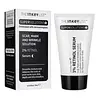What's inside
What's inside
 Key Ingredients
Key Ingredients

 Benefits
Benefits

 Concerns
Concerns

 Ingredients Side-by-side
Ingredients Side-by-side

Cyclopentasiloxane
EmollientCaprylyl Methicone
Skin ConditioningC12-15 Alkyl Benzoate
AntimicrobialUndecane
EmollientDimethicone/Vinyl Dimethicone Crosspolymer
Skin ConditioningTrisiloxane
Skin ConditioningDimethyl Isosorbide
SolventPEG-7 Glyceryl Cocoate
EmulsifyingPentylene Glycol
Skin ConditioningNiacinamide
SmoothingTridecane
PerfumingSodium Hyaluronate Crosspolymer
HumectantPEG-12 Dimethicone
Skin ConditioningMethyl Methacrylate/Glycol Dimethacrylate Crosspolymer
Bisabolol
MaskingRetinol
Skin ConditioningHydroxypinacolone Retinoate
Skin ConditioningAscorbic Acid
AntioxidantTocopheryl Acetate
AntioxidantSilica Silylate
EmollientZea Mays Starch
AbsorbentTetrahexyldecyl Ascorbate
AntioxidantPhenylpropanol
MaskingPolysorbate 20
EmulsifyingCaprylyl Glycol
EmollientPropanediol
SolventSilica
AbrasiveDimethicone
EmollientPropyl Gallate
AntioxidantDisodium EDTA
BHT
AntioxidantTocopherol
AntioxidantCyclopentasiloxane, Caprylyl Methicone, C12-15 Alkyl Benzoate, Undecane, Dimethicone/Vinyl Dimethicone Crosspolymer, Trisiloxane, Dimethyl Isosorbide, PEG-7 Glyceryl Cocoate, Pentylene Glycol, Niacinamide, Tridecane, Sodium Hyaluronate Crosspolymer, PEG-12 Dimethicone, Methyl Methacrylate/Glycol Dimethacrylate Crosspolymer, Bisabolol, Retinol, Hydroxypinacolone Retinoate, Ascorbic Acid, Tocopheryl Acetate, Silica Silylate, Zea Mays Starch, Tetrahexyldecyl Ascorbate, Phenylpropanol, Polysorbate 20, Caprylyl Glycol, Propanediol, Silica, Dimethicone, Propyl Gallate, Disodium EDTA, BHT, Tocopherol
Water
Skin ConditioningGlycerin
HumectantPrunus Armeniaca Kernel Oil
MaskingPersea Gratissima Oil
Skin ConditioningCaprylic/Capric Triglyceride
MaskingSqualane
EmollientCetearyl Alcohol
EmollientGlyceryl Stearate Se
EmulsifyingRetinol
Skin ConditioningPhenoxyethanol
PreservativeHydroxyethyl Acrylate/Sodium Acryloyldimethyl Taurate Copolymer
Emulsion StabilisingBenzyl Alcohol
PerfumingPhospholipids
Skin ConditioningTocopherol
AntioxidantPolyacrylate Crosspolymer-6
Emulsion StabilisingGlycine Soja Oil
EmollientEthylhexylglycerin
Skin ConditioningGlycolipids
Skin ConditioningDehydroacetic Acid
PreservativePolysorbate 60
EmulsifyingSorbitan Isostearate
EmulsifyingTrisodium Ethylenediamine Disuccinate
Glycine Soja Sterols
EmollientT-Butyl Alcohol
PerfumingWater, Glycerin, Prunus Armeniaca Kernel Oil, Persea Gratissima Oil, Caprylic/Capric Triglyceride, Squalane, Cetearyl Alcohol, Glyceryl Stearate Se, Retinol, Phenoxyethanol, Hydroxyethyl Acrylate/Sodium Acryloyldimethyl Taurate Copolymer, Benzyl Alcohol, Phospholipids, Tocopherol, Polyacrylate Crosspolymer-6, Glycine Soja Oil, Ethylhexylglycerin, Glycolipids, Dehydroacetic Acid, Polysorbate 60, Sorbitan Isostearate, Trisodium Ethylenediamine Disuccinate, Glycine Soja Sterols, T-Butyl Alcohol
Ingredients Explained
These ingredients are found in both products.
Ingredients higher up in an ingredient list are typically present in a larger amount.
Retinol is a gold-standard ingredient for anti-aging. It is a form of Vitamin A and belongs to the class of retinoids that also includes tretinoin.
Why is retinol famous?
It has the most scientific studies backing up its skin benefits out of all the non-prescription ingredients.
Retinol is proven to:
This is why retinol is effective at removing wrinkles, fading dark spots, treating acne, and reducing the appearance of pores.
Studies show retinol is less effective when exposed to UV. Be sure to look for appropriate packaging to keep your retinol potent (similar to Vitamin C).
Using retinol or any retinoids will increase sun-sensitivity in the first few months. Though studies show retinoids increase your skin's natural SPF with continuous use, it is best to always wear sunscreen and sun-protection.
We recommend speaking with a medical professional about using this ingredient during pregnancy.
Retinol may cause irritation in some people, so be sure to patch test. Experts recommend 'ramping up' retinol use: start using this ingredient once a week and work up to using it daily.
Read about Tretinoin
Learn more about RetinolTocopherol (also known as Vitamin E) is a common antioxidant used to help protect the skin from free-radicals and strengthen the skin barrier. It's also fat soluble - this means our skin is great at absorbing it.
Vitamin E also helps keep your natural skin lipids healthy. Your lipid skin barrier naturally consists of lipids, ceramides, and fatty acids. Vitamin E offers extra protection for your skin’s lipid barrier, keeping your skin healthy and nourished.
Another benefit is a bit of UV protection. Vitamin E helps reduce the damage caused by UVB rays. (It should not replace your sunscreen). Combining it with Vitamin C can decrease sunburned cells and hyperpigmentation after UV exposure.
You might have noticed Vitamin E + C often paired together. This is because it is great at stabilizing Vitamin C. Using the two together helps increase the effectiveness of both ingredients.
There are often claims that Vitamin E can reduce/prevent scarring, but these claims haven't been confirmed by scientific research.
Learn more about Tocopherol